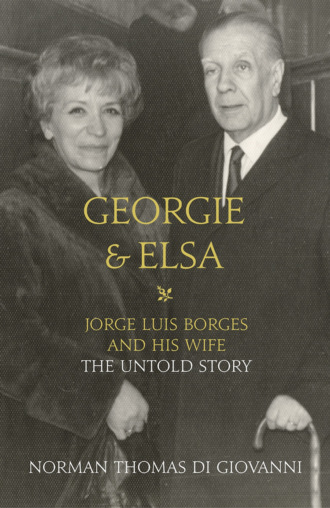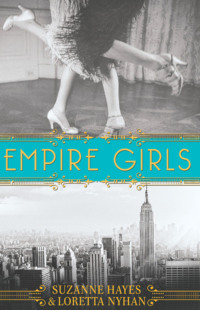
Полная версия
Georgie and Elsa: Jorge Luis Borges and His Wife: The Untold Story



Dedication
To M., who guided and inspired
To Derek and to Tom
Contents
Cover
Title Page
Dedication
Prologue: A Figure of Speech
1. Celebrating the Marriage
2. A History of the Romance
3. Off on the Wrong Foot
4. The Norton Lectureship
5. Meeting Borges and Setting Out with a Master
6. Georgie’s Mystery, Elsa’s Bombshell
7. A Visitor and a Yard of Ale
8. Vietnam, Olga, and Harvard Square
9. Borges on Tour
10. Invitations and Goodbyes
11. Interregnum
12. Arrival
13. Settling In
14. The Recoleta
15. Cracks in the Façade
16. Oklahoma and the Fur Coat
17. Hobnobbing with the Rockefellers
18. New York and the Fur Coat
19. Buenos Aires and the Fur Coat
20. Silent Sufferer
21. An Aside
22. The Breaking Point
23. The Reckoning
24. Amongst the Lawyers
25. The Night of the Oxford Martyrs
26. Escape to Córdoba
27. The Mosquito and the Judge
28. The Salem Mystery Solved
29. Return to Maipú
30. Looking Back
Epilogue: Ave Atque Vale
A note on Borges
Picture Section
Copyright
About the Publisher
Prologue
A Figure of Speech
Synecdoche, a part standing for the whole.
In 1944, in the kind of incisive and highly literary statement typical of him, the celebrated Argentine poet and storyteller Jorge Luis Borges postulated in one of his tales that ‘Any life, no matter how long or complex it may be, is made up essentially of a single moment – the moment in which a man finds out, once and for all, who he is.’
Borges’s ultimate fame as a writer is based on a mere thirty-four stories written between 1933 and 1953 and published in two collections, Ficciones and El Aleph. His fiction was unpopular at the time, considered cryptic and abstruse, and it wasn’t until he was in his seventies that he began to be swamped with awards and prizes and honours – among them, honorary degrees from both Oxford and Cambridge.
At birth he had been given his father’s first name. In a household of English speakers – with a grandmother and great aunt of English stock – it was only natural that to distinguish father and son he be dubbed Little Jorge, or Georgie. The name stuck. To his family and to a handful of intimates he was known ever after as Georgie.
The story told here in Georgie & Elsa, in which I was both reluctant witness and tricky participant, took place in a three-year span between 1967 and 1970. What I have recounted, besides depicting and illuminating hitherto unknown facts and events in the couple’s affairs, is an attempt to find out whether a person’s life can be typified by a single part of it. Can the ups and downs and vicissitudes of a brief marriage reflect and define the essential character of either of the partners in that alliance? In short, can a marriage of only a few years’ duration reveal a man’s whole life? The man is Borges. What does his short, failed marital union with Elsa Astete Millán tell us about him?
1. Celebrating the Marriage
Jorge Luis Borges and Elsa Astete Millán were married at a Buenos Aires registry office on 4 August 1967. The occasion seems not to have excited the notice of the press. On 21 September came a follow-up ceremony in the Iglesia de Nuestra Señora de las Victorias, where both Borges’s mother Leonor and his sister Norah – the two of a religious bent – had married.
These events took place on the eve of Borges’s departure for Harvard University, where, over the following months, he was to deliver the prestigious Charles Eliot Norton lectures. Hitherto a life-long bachelor, Borges was sixty-eight years old at the time of the wedding; Elsa, a widow, with a son in his twenties, was eleven years younger. The trip to Cambridge she described as her honeymoon; as for the lectureship she appeared to look on it as an altogether secondary matter.
The church of their marriage had been built in 1880 in the plain neo-Gothic style of the time and place, the belltower and steeple, with its four pinnacles, towering over the buildings crowded round it. Soon after, in 1883, the edifice was given to the Congregation of the Redemptorists on the day of their first arrival in Buenos Aires. Founded in Italy in 1732, the Congregation is a missionary society whose aim is to put into action Jesus Christ’s command to ‘Love one another as I have loved you.’ In 1884, the Church of Our Lady of the Victories also became a seat of the cult of Our Mother of Perpetual Help, the Byzantine icon of which the Redemptorists are caretakers. Such was the improbable and incongruous setting for the marriage of a man of Borges’s well-known agnosticism and sceptical turn of mind.
In the published pictures of the church ceremony Borges stood staring ahead, hands behind his back, with Elsa on his right and his mother of ninety-one on his left. The church was packed with friends and well-wishers, along with numerous members of the press and their accompanying photographers. The bride wore a black coat-dress, with a pair of long black gloves, and a white turban-like hat with a short, gauzy veil over thick false eyelashes. Neither Georgie nor Elsa looked as if it were the happiest day of their lives. While Leonor appeared solemn, the couple seemed glum.
According to Borges, on the day of their civil marriage his mother told Elsa that to her only a church ceremony counted. The gauntlet had been firmly thrown down at Elsa’s feet.
2. A History of the Romance
There is no definitive account of the romance – early, middle, or late – between Georgie and Elsa. Dates are absent or contradictory, and the resulting picture is full of gaps and distortions. There are her versions of events but little from Borges’s side except for some brief remarks he once made to me about why he married her. (His explanation smacked at one and the same time as overly literary and foolishly romantic.)
Elsa recalled their initial meetings in a rosy and seemingly sincere way while she and Borges were married but after they separated her emphasis changed. She now glossed over those early days and spoke more of their life together. In her recollections of both times there are false notes and plain untruths, especially when she describes the latter years. Surprisingly, looking back on the marriage and her relationship with Borges in 1983, when she was seventy-two and Borges still had three years to live, she expressed neither bitterness nor resentment nor recriminations. In fact, she presented a blissful, storybook picture of their entire married life that had little to do with reality. For some unknown reason she was putting the best possible face on events that had not been pleasant for her.
So what we have is a series of fragments, many of them unreliable. In the maze and tangle of what really took place in the romance – somewhere – lies the irreducible truth. By now, however, that truth is elusive if not irretrievable.
The story begins, according to one Elsa version, which she recounts with girlish enthusiasm and hints of prophetic significance, when she was seventeen and Borges twenty-eight. That would have made it 1927. (Other accounts give their ages as twenty and thirty-one, but for a moment let’s follow Elsa’s lead.)
She grew up on the fringes of La Plata, then a pleasant university town and capital of the Province of Buenos Aires, an hour or so southeast of the city of Buenos Aires. The university was renowned for its distinguished faculty, its important library, and a celebrated Natural History Museum. Founded in 1882, La Plata was carefully laid out on a grid plan; it had intersecting diagonal avenues and it boasted impressive woodlands and parks and public buildings. Elsa remembered it sentimentally as ‘a beautiful, never-to-be-forgotten city, fragrant with its lindens.’
She described herself at the time as una jovencita vistosa – an attractive young woman. One day she accepted an invitation from Pedro Henríquez Ureña, an outstanding scholar and literary figure, to have tea that afternoon at his home. Some young writers from Buenos Aires had also been invited, among them – fatefully – Borges. ‘I say fatefully’, Elsa recounted, ‘because I did not want to accept the invitation. I no doubt had another engagement, which I did not want to break.’ She arrived at Henríquez Ureña’s in a bad mood and took her good time about entering the room where the others were gathered. She claimed that from the time she was a small girl she had been in the habit of not speaking when anything or anybody displeased her. (She noted that the habit was one she never lost.) So she took a seat in an armchair and did not utter a word. Georgie stared at her, he too speechless. Later he confessed to her that he had been terrified. She claims to have found him a kind, talented, good-looking young man. These last words were an obvious sop to Borges, who was present when Elsa spoke them. If on their first meeting both were tongue-tied, she could hardly have judged his kindness or his literary talent. As for his looks, Borges in the twenties was decidedly unprepossessing. At one point he wore thick spectacles that greatly magnified his eyes, and his right eyelid drooped. Later he began to put on weight and grew a beard. In all these stages he was extremely awkward in the presence of the opposite sex. Elsa had been upset on the day because she’d had to give up a date with some other man. Yet if there is any truth to her stories something must have been in the air, for she mentions that many pleasant afternoons were to follow, both in La Plata and in Buenos Aires, and she names the different tea shops she and Borges frequented.
Another version of events states that Henríquez Ureña had invited Elsa and her sister Alicia on a sort of blind date to a lecture at the Museum of Fine Arts. The speaker turned out to be Néstor Ibarra, who was one day to marry Alicia. The young man who’d accompanied him to La Plata was Borges. Elsa is quoted as saying that ‘after Henríquez Ureña introduced us we had tea at the Jockey Club, and the next week Alicia and I went to Buenos Aires, where we all met up. From then on Borges never left me alone. He pursued me night and day. It was on our first date that he swore his eternal love for me.’
For how long this went on we do not know. It has been claimed that they were sweethearts for two years and that there was even talk of marriage, but Elsa once remarked that she couldn’t remember if they were ever formally engaged. Interviewed in 1983, she spoke of having been Borges’s fiancée when she was twenty years old. ‘We had even exchanged rings,’ she said. ‘We were properly engaged.’
Again, taking the lead from Elsa, let us now say she was twenty. That would have made Borges thirty-one and the year 1930. She claimed that a besotted Borges journeyed to La Plata every Saturday to see his beloved. But what the beloved never revealed to him was that she had fallen in love with someone else, with whom she was carrying on a clandestine relationship. Borges, incredibly callow, was the last person to find out. One variant of the story quotes Elsa as saying that ‘A fortnight after I was married, Borges, who knew nothing about it, kept phoning my house. My mother did not know what to say to him, and I washed my hands of the matter. I told her it was her problem. Finally, being very correct, my mother answered one of his calls and said, “Look, Borges, pardon me, but I feel obliged to tell you something. Don’t phone any more; Elsa is married.”’ The mother reported that there was a short silence down the telephone and then Borges said, ‘Ah, caramba,’ and he hung up.
There is something amusing about this story, but it does Elsa no credit, while it makes an utter fool of Borges. Can things really have happened in this way? Was Elsa’s memory plainly unreliable or was she simply good at invention? When would these events have taken place? We know that Elsa was not married until 1937. Several years are unaccounted for here.
While there is no full or straightforward account of the romance there is no end of inconsequential variations. In one, María Millán, Elsa’s mother, ran a boarding house, where Borges stayed during his visits and where Henríquez Ureña was a lodger. It was here, not at the professor’s home nor at the Museum of Fine Arts, that Elsa first met Borges.
One thing only seems certain – that this was Borges’s first of several experiences of being deceived and jilted by a woman. What lesson did he derive from the Elsa misfortune?
In the whole fraught saga of his star-crossed relationship with Elsa, what happened next, early in 1944, must rank as one of the strangest turns in Borges’s life. By this time Elsa had been married since 1937 to one Ricardo Albarracín Sarmiento, by whom she had a son. In this seven-year interim she and Borges are not known to have been in contact. Under what circumstances then and by what plotting did he meet Elsa again? All we know is what he wrote to her in two love letters, both composed in the same week. These mysterious billets-doux, giving no hint of a before or an after, seem to have materialized out of nowhere, led nowhere, and ended nowhere.
The first of these impassioned letters, written on 31 January, reveals that Georgie and Elsa had met the day before, an encounter that unleashed a veritable Niagara of emotion in the normally buttoned-up Borges. Apart from his amatory outpourings, he says he would like to overwhelm her with a detailed description of his room, with his bookcase containing the Encyclopædia Britannica, his shelves of Chesterton’s works, and his various editions of the Arabian Nights. And he recommends that she read the anthology of fantastic literature that he had compiled a few years earlier with his friends Adolfo Bioy Casares and Silvina Ocampo.
In the second letter, written on 4 February, he tells Elsa that two days earlier he had gone to Sur, the leading literary magazine of the period, to correct the proofs of his latest short story and to add a dedication. The dedication was one he had obviously promised her when they met. Indeed when the issue of Sur appeared his tale bore the inscription ‘To E.H.M.’, initials standing for Elsa Helena Millán. The missive goes on to say that the Sunday editions of both Buenos Aires papers, La Prensa and La Nación, are reviewing a book of his poems. We learn that the following week he is going to ‘undertake a pilgrimage to La Plata.’ And he closes telling her that he is in the midst of correcting the final proofs of Sarmiento’s nineteenth-century classic Recuerdos de provincia, wherein her surname – that is, her husband’s surname, Albarracín – appears countless times, as well as revising Spanish translations of Carlyle and Emerson and completing ‘a long metaphysical essay for Sur.’
So much for the letters’ factual information. It is almost unbelievable that Borges would seek to impress or attempt to attract a young married woman with no literary interests whatsoever by reciting to her the contents of his library shelves or the trivia of his proofreading, editing, or writing activities. The dedication, yes, may have proved momentarily flattering, but the rest in a man of forty-four is more like the hopeful but clumsy groping and fumbling of an adolescent.
More revealing are the overblown expressions of love. ‘To have witnessed the birth and death of your slow smile, to have heard the precious modulations of your voice, to have recaptured for a few hours the intricate delight of your company …’ He then tells Elsa she is not just a miracle but is also indispensable, and he begs her not to go out of his life. On it goes; each bit of his soul-baring, each of his declarations, more embarrassing than the last. ‘Those who suffer the misfortune of not being Helena Astete Millán have no reality for me …’
What on earth could have provoked these pathetic effusions – pleading with Elsa to deliver him from his loneliness and the pointlessness of his existence, admitting to a fear that while he remembers her he may no longer exist in her memory? All so uncharacteristic of the Borges he allowed the public to see.
For anyone else this isolated episode might have been a simple aberration. But for Borges it was part of a recurring pattern. As ever with him, we must look for an explanation in the ongoing frustrations and failures of his love life, in the string of rejections he suffered at the successive hands of women he fell in love with, or imagined he was in love with, but who in time either spurned him outright or strung him along or simply failed to respond to his style of literary advances. Borges’s love life was always a cerebral business.
What seems to have triggered the 1944 letters to Elsa was a reaction. Borges had endured a long-running obsession with Norah Lange, a captivating redhead, a poet whose first book he had assiduously promoted in 1925 and to whom he soon became romantically attached. She was Nordic, tall, good-looking, and with flaming hair – by his standards everything a woman should be. By 1931, however, Norah was conducting a secretive on-and-off affair with another poet, Oliverio Girondo. This was a blow to Borges, but when Oliverio departed for Paris, Borges’s hopes began to wax again. Then, when his rival returned, the hopes – always a private intellectual exercise – once more waned. Norah and Oliverio lived together for nearly a decade and in June 1943 were quietly married. Meanwhile, Haydée Lange, Norah’s sister, had an unstable boyfriend who was convinced that Borges was carrying on with his fiancée. He spied on Haydée, trying to catch Borges. At the end of 1943 the young man was found drowned in the harbour.
It was at this time that Borges’s mind seemed to snap and he reacted by trying to revive his old relationship with Elsa. What we don’t know is how the earlier connection with Elsa fit in chronologically with Borges’s ongoing love of Norah Lange, which in fact he never got over.
Elsa, who was the most jealous of women, admitted in her last years that Borges was always in love, that he needed love (‘even if perhaps this is not quite the right word for it’), that he needed a woman by his side. When his feelings for one were over, he soon found a replacement. ‘But for some unknown reason,’ Elsa went on, ‘he never managed to make anything permanent with any woman.’ Was she being coy in this last remark or was it some sort of cryptic cover-up?
With regard to the love letters of 1944, as mysteriously and unexpectedly as the isolated episode had risen it simply faded or went underground. There were no repercussions at the time, and the event appeared to vanish from Borges’s life. When in 1944 he published in book form the story dedicated with fanfare to Elsa twelve months before, oddly the dedication was shifted to another of the collection’s stories, which was dated 1942. As for the fate of the two letters, in 1986 Elsa unsuccessfully offered them for auction at Sothebys in New York, but the suggested price of $4,000-6,000 had apparently been deemed by the public as too high. Also oddly, when asked in 1983 whether Borges ever dedicated a book to her, Elsa remembered a book and a poem. She was wrong about the book, right about the poem, but all memory of the story seemed to have slipped her mind. The omission of the name Astete from the dedication, by the way, may have been a nicety on Borges’s part. He once told me that Elsa hated the name, since as a schoolgirl she had been teased for it by the other children. In Spanish the last two syllables, tete, are close to meaning ‘tit’.
The third and final phase of Borges’s infatuation with Elsa is as fragmentary and hard to pin down as the first two. We have few hard facts or solid documentation, but reams of gossip and much partisan speculation by a parade of busybodies. Commentators and biographers, long after the event, have resorted to interviews with some of Borges’s friends and members of his and his mother’s social set. None of this gleaned information has been closely scrutinized or sifted for the truth. The recordists appear to have taken at face value whatever they were told. What has been recorded of Elsa’s point of view is banal and evasive.
The question of who engineered the marriage – was it doña Leonor? was it Borges? – is still ambiguous. Doña Leonor swore to me that her son was adamant about marrying Elsa. Borges swore to me that his mother was adamant that he marry Elsa. His testimony must be questioned. Whenever Borges found himself in a tight or embarrassing corner he was notorious for exculpating himself and falling back on lies. The grossest example of this was the blame he laid on his mother for his marriage to Elsa.
In 1965, when he was offered the Harvard lectureship, a decision had to be made about who would accompany him to Massachusetts. His mother, who had previously fulfilled the role of travelling companion, was approaching her nineties. A suitable person was deemed necessary. Up to this time Borges had been enjoying the company of María Esther Vázquez, a young writer and journalist nearly forty years his junior, who in 1964 had accompanied him on a long meandering European journey. It is said that on his return their relationship – as was inevitable with Borges – had become closer, much to doña Leonor’s disapproval. She did not want to see him in the position of Professor Rath with Lola-Lola of the Blue Angel. Any younger woman, she feared, would take advantage of her son; in short, Georgie needed someone older. María Esther accompanied him to Peru early in 1965, but by this time her intentions had been made clear. To Borges’s distress she had married the poet Horacio Armani. Once more Georgie’s romantic fortunes were repeating themselves. (It is worth noting that several months after he and Elsa married – this was at the time I first knew them in Cambridge – it was María Esther he often spoke to me about with a poignant nostalgia when out of Elsa’s earshot. He also spoke to me this same way, but to a lesser extent, of one of his students, Vlady Kociancich, on whom it was plain to me that he had a crush.)
One version of Elsa’s reappearance on the matrimonial scene tells that Borges’s mother learned that Elsa was now a widow and urged her son to contact her. A meeting was arranged via Elsa’s sister Alicia. Elsa showed Borges a ring he had given her years before; he was moved that she had kept it. Borges later showed Elsa a photograph of her that he had kept between the leaves of a book; doña Leonor told Elsa that for years he looked at it every night before going to bed. All this is too pat and smacks too much of a fairy tale to ring true.
Exactly when these events were supposed to be taking place we do not know. There was some mention of Elsa’s qualifications, as she knew no English. A second version of the story is that another of Borges’s old flames, Margarita Guerrero, was mooted as a possible wife. This too seems to me an absurdity. Margot, as she was known, was a striking beauty, tall, elegant, and worldly. All the things Elsa was not. Was Margot one more of Borges’s – or his mother’s – preposterous fancies?











